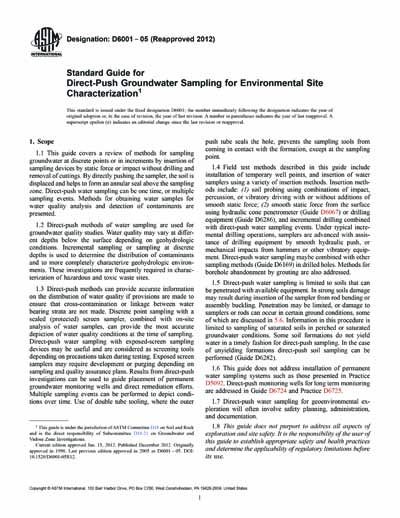Historical
ASTM D6001-05(2012)
Standard Guide for Direct-Push Groundwater Sampling for Environmental Site Characterization
1.1 This guide covers a review of methods for sampling groundwater at discrete points or in increments by insertion of sampling devices by static force or impact without drilling and removal of cuttings. By directly pushing the sampler, the soil is displaced and helps to form an annular seal above the sampling zone. Direct-push water sampling can be one time, or multiple sampling events. Methods for obtaining water samples for water quality analysis and detection of contaminants are presented.
1.2 Direct-push methods of water sampling are used for groundwater quality studies. Water quality may vary at different depths below the surface depending on geohydrologic conditions. Incremental sampling or sampling at discrete depths is used to determine the distribution of contaminants and to more completely characterize geohydrologic environments. These investigations are frequently required in characterization of hazardous and toxic waste sites.
1.3 Direct-push methods can provide accurate information on the distribution of water quality if provisions are made to ensure that cross-contamination or linkage between water bearing strata are not made. Discrete point sampling with a sealed (protected) screen sampler, combined with on-site analysis of water samples, can provide the most accurate depiction of water quality conditions at the time of sampling. Direct-push water sampling with exposed-screen sampling devices may be useful and are considered as screening tools depending on precautions taken during testing. Exposed screen samplers may require development or purging depending on sampling and quality assurance plans. Results from direct-push investigations can be used to guide placement of permanent groundwater monitoring wells and direct remediation efforts. Multiple sampling events can be performed to depict conditions over time. Use of double tube tooling, where the outer push tube seals the hole, prevents the sampling tools from coming in contact with the formation, except at the sampling point.
1.4 Field test methods described in this guide include installation of temporary well points, and insertion of water samplers using a variety of insertion methods. Insertion methods include: (1) soil probing using combinations of impact, percussion, or vibratory driving with or without additions of smooth static force; (2) smooth static force from the surface using hydraulic cone penetrometer (Guide D6067) or drilling equipment (Guide ), and incremental drilling combined with direct-push water sampling events. Under typical incremental drilling operations, samplers are advanced with assistance of drilling equipment by smooth hydraulic push, or mechanical impacts from hammers or other vibratory equipment. Direct-push water sampling maybe combined with other sampling methods (Guide ) in drilled holes. Methods for borehole abandonment by grouting are also addressed.
1.5 Direct-push water sampling is limited to soils that can be penetrated with available equipment. In strong soils damage may result during insertion of the sampler from rod bending or assembly buckling. Penetration may be limited, or damage to samplers or rods can occur in certain ground conditions, some of which are discussed in 5.6. Information in this procedure is limited to sampling of saturated soils in perched or saturated groundwater conditions. Some soil formations do not yield water in a timely fashion for direct-push sampling. In the case of unyielding formations direct-push soil sampling can be performed (Guide D6282).
1.6 This guide does not address installation of permanent water sampling systems such as those presented in Practice D5092. Direct-push monitoring wells for long term monitoring are addressed in GuideD6724 and Practice D6725.
1.7 Direct-push water sampling for geoenvironmental exploration will often involve safety planning, administration, and documentation.
1.8 This guide does not purport to address all aspects of exploration and site safety. It is the responsibility of the user of this guide to establish appropriate safety and health practices and determine the applicability of regulatory limitations before its use.
1.9 This guide offers an organized collection of information or a series of options and does not recommend a specific course of action. This document cannot replace education or experience and should be used in conjunction with professional judgment. Not all aspects of this guide may be applicable in all circumstances. This ASTM standard is not intended to represent or replace the standard of care by which the adequacy of a given professional service must be judged, nor should this document be applied without consideration of a project's many unique aspects. The word ???Standard??? in the title of this document means only that the document has been approved through the ASTM consensus process.
ASTM International [astm]

